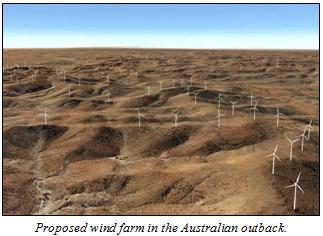NYT “Green Column” Promotes Renewable Efforts in Australia that Collide with Economic Realities
By Kevin Mooney
So called renewable energy sources comprise just 6 percent of Australia’s power supplies, but this could change dramatically in the next few years if environmentalists have their druthers, according to a New York Times “Green Column” that highlights pending projects. Current plans call for the largest wind farm in the Southern Hemisphere to be built between now and 2013, the report says.
Although the report concedes that there are enormous logistical challenges connected with the project, it permits renewable industry advocates to talk around the engineering obstacles. The NYT also claims the renewable energy initiatives will generate modest costs for Australian citizens. But the experiences of European countries and U.S. states suggest otherwise and should be reported.
Gabriel Calzada, an economics professor at Universidad Rey Juan Carlos in Spain, has produced a study that shows green jobs are mostly temporary, heavily subsidized and subtract away from economic performance. The study also describes how higher energy prices associated with renewable have worked against Spain’s ability to compete internationally. The same is true in the U.S. where electricity rates are almost 40 percent higher in states with renewable standards than they are in states that do not have such standards, according to the Institute for Energy Research (IER).
Readers would greatly benefit if these numbers were juxtaposed with some of the blanket assertions made in the NYT piece. Unrealistic cost estimates are typically attached to political agendas at odds with the public interest. Ideally, journalists should work to expose rather than advance government perfidy.
Australia could switch over to renewable in just 10 years by constructing 12 thermal solar stations and 23 wind farms, a Melbourne University study cited in the report has concludes.
“This ambitious clean energy network would cost 370 billion dollars over 10 years, but the cost to each household is estimated at a mere 8 dollars a week,” the article declares. This is very questionable number in light of what has been experienced in America and Europe. But policymakers are proceeding full speed ahead.
“Worldwide, investment in renewable energies has boomed in recent years, with some $190 billion worth of new clean energy in 2008, according to the Renewables Global Status Report for 2009,” the report says. “The number of large solar plants tripled to 1,800 between 2007 and 2008, with the majority of new plants in Spain, the Czech Republic, France, Germany, Italy, South Korea and Portugal. The United States, the world’s biggest source of wind energy, installed five times Australia’s total wind energy capacity in 2008 alone.”
Yes, and it’s costing these countries a substantial amount without any appreciable impact on the climate at the expense of cheap, reliable energy sources. The NYT does a great disservice to readers here by way of cheerleading for renewable development in a country that has plenty of alternatives. Instead, it views Australia’s rich supply of resources as an obstacle.
“One of the problems in Australia is that the country has too many energy resources, and too much cheap coal,” the NYT observes. “The country is the leading exporter of coal in the world, and it generates about 80 percent of its electricity through coal-fired power stations.”
The political class understands that coercive measures such as “cap and trade” are needed to force private industry off politically incorrect energy sources. But key voices of dissent have emerged and that’s good news for Australians.
“While campaigning for elections on Saturday, the governing Labor Party and the conservative opposition appeared divided over whether to set such a `carbon price,’ which would force coal power operators to invest in cleaner technology and make renewable energy more competitive,” the report says. Prime Minister Julia Gillard favors what the NYT describes as a “market-based carbon program,” while Tony Abbott is opposed.
Although environmental groups maintain that “cap and trade” policies have market-like qualities, their arguments do not hold up, especially on the cap side of the equation. The emissions restrictions are imposed through regulation not voluntary, market-based decisions. Moreover, because they are set through regulation and legislation they can be imposed for political reasons, not economic or environmental reasons.
This remains an unexplained part of the story that should be pursued and unpackaged in future reports.
Kevin Mooney is a contributing editor to Americans for Limited Government (ALG) News Bureau, and the Executive Editor of TimesCheck.com.


